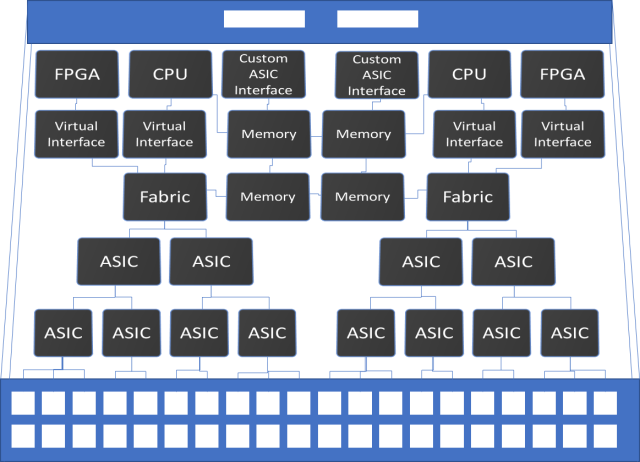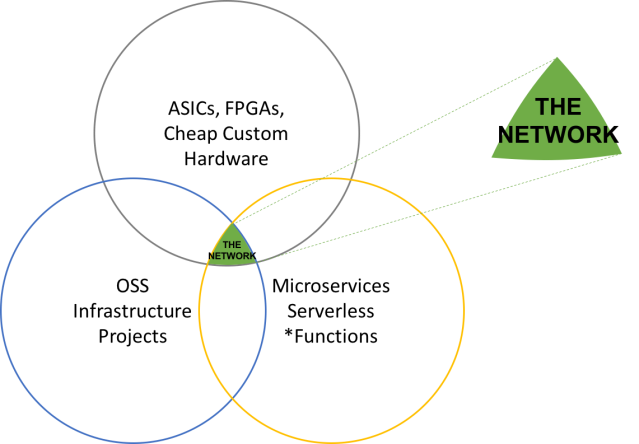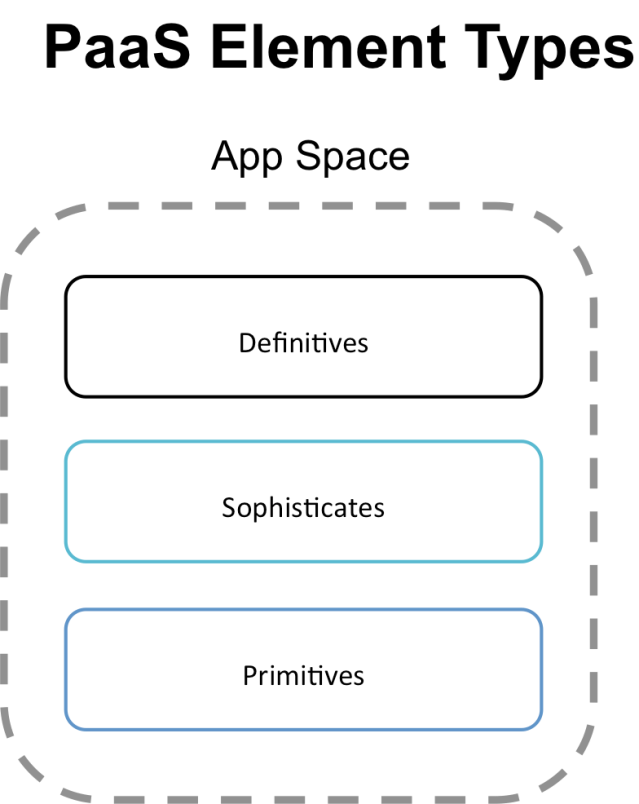We often speak of data with the characteristics of information, I’m guilty of this just as much as anyone. The distinction is important to make however, Data being a thing such as a number “32”. With only “32” this number could mean anything, it could mean the number of cows on a farm, the number of […]
The Periodic Point
Over 20 years ago, I started my professional career joining GE working as a Systems Engineer for a large bank and doing several public sector assignments. After a few years, I worked for Sprint. Several years later, I founded my first startup which was sold to Quest Software (which in turn was bought by Dell). […]
Networks, Openness, Istio (The Future of Networks Part 4)
This is Part Four in the series “The Future of Networks”, to start at the beginning go here. There are many possibilities as to where the previously mentioned trends drive networking. As I continue to interact with the community and evolve my thoughts about the Future of Networks, I am going to cover more of […]

Beyond the Network (The Future of the Network, Part 3)
Beyond the Network This post the third in a series: To read them in order, start here. Imagine for a moment that if instead of treating each server (or container, or vm) as if it is one or more network hops away, that the server was directly attached to the services and other servers that it needs […]

The Future of the Network, Part 2
This post is the second in a series: To read them in order, start here. There are three trends that I have seen happening over the past few years that are indirectly or directly influencing the future of networks; The first is the use of FPGAs and ASICs to solve problems around distributed applications and network […]
The Future of the Network
This is part 1 of 5 in a series that will be posted daily this week. The Future of the Network or “Direct-Connect Switchless Networks” For the past few months, I have been considering how Networking technology will (and in some cases should) evolve over the next 3–7 years. Networking technology has stagnated from the breakneck […]
Change is good
As I continue my journey through Cloud Computing, Big Data, Networking, DevOps and more, I have decided to make another change. Today is my first day at Warner Music Group, where I will be assuming the role of SVP of DSP Engineering (aka SVP of Platform Engineering). There may be speculation as to why I […]
Artificial Data Gravity
Having covered Data Gravity several times on this blog, I thought that it would be time to cover a derivative topic: Artificial Data Gravity. Recall that Data Gravity is the attractive force created by Data amassing and the needs of Apps and Services to leverage low latency and high bandwidth. Artificial Data Gravity is the […]

PaaS Element Types
Please Note : This post builds directly on the previous post “A viable PaaS Model” What are PaaS Element Types? PaaS Element Types are the constructs required to build a PaaS. Each PaaS Element Type builds upon the previous, I’m not the first to come up with the overall concept of Types building upon one […]
A viable PaaS Model
What makes a PaaS a PaaS? I’ve seen many discussions on blogs and twitter around this topic, so much so that many people are tired of talking about it because it always leads to cyclical discussions. I for one haven’t been satisfied with any of the answers that I have seen. Some people try to […]
Defying Data Gravity
How to Defy Data Gravity Since I have changed companies, I have been incredibly busy as of late and my blog has had the appearance of neglect. At a minimum I was trying to do a post or two per week. The tempo will be changing soon to move closer to this…. As a first […]
IaaS and SaaS lead to PaaS
Most people currently portray the Public Clouds as a stack consisting of IaaS, PaaS, and SaaS. Worse still, they try to define Private Clouds in the same way. In a discussion I had with Christofer Hoff – @Beaker he accurately pointed out that this isn’t entirely the case, that they are all really Integrations. This blog […]
Service Energy – Complimenting Data Gravity
It has been a while since I posted anything referring to Data Gravity. While Data Gravity is interesting and can explain many motivations of Cloud Companies and their Data Services, there are other influential forces at work. Service Energy What am I referring to as a Service in this case? Any code or logic that […]
The Future of PaaS in the Enterprise – The Service Oriented Platform
Anyone who followed Cloud Computing last year watched several changes occur throughout the space. These changes were happening in the view of what Public, Private, and Hybrid Clouds were defined as, the interest in IaaS solutions in the Enterprise and within Service Providers, and finally a renewed interest in the potential of PaaS. Currently Public […]
Current PaaS Patterns – Types of PaaS
There are many definititions of PaaS that I have run across, the most succinct of which is “A Service where Code is uploaded and executed”. While succinct, this leaves a lot of “wiggle room” for what PaaS really is. The secret is PaaS isn’t one thing, it is a broad array of things that can […]
Hyper9 is acquired by SolarWinds
The company I founded a few years ago has been acquired by SolarWinds Inc. I’m pleased with the outcome and proud of all of those involved in the hard work it has taken to get here. Details can be found here
CLASH – CLoud Admin SHell
It has been several weeks since I have posted to this blog. I would blame this on the holidays, but that would be inaccurate as it has been something far more insidious! What is CLASH? CLASH is a universal shell. What is a universal shell? First, by universal I mean that it is intended to […]
Cloud Escape Velocity – Switching Cloud Providers
The term Escape Velocity is the speed needed to “break free” from a gravitational field without further propulsion according to Wikipedia.org. Data Gravity as explained in THIS previous post is what attracts and builds more Data, Applications, and Services on Clouds. Data Gravity also is what creates a high level of Escape Velocity to move to […]
Microsoft Azure Cloud – Top 20 Lessons Learned about MSFT’s PaaS
Two weeks ago, Rob Hirschfeld (@Zehicle) and I (@McCrory) had the benefit of intensive Azure training at Microsoft HQ to support Dell’s Azure Stamp. We’ve assembled a top 20 list of things to know about programming for Azure (and really any PaaS leaning cloud): If you want performance, optimize to reduce fees. Azure (and any […]
Data Gravity – in the Clouds
Today Salesforce.com announced Database.com at Dreamforce. I realized that many could be wondering why they decided to do this and more so, why now? The answer is Data Gravity. Consider Data as if it were a Planet or other object with sufficient mass. As Data accumulates (builds mass) there is a greater likelihood that additional […]
Public Cloud Comparison and Calculator v2
After some time away from the Public Cloud Compute Comparison that I did a couple of months ago (which got X hits), I decided to update it based on feedback and new ideas. What follows is a brief walkthrough with instructions on how to use the Calculator. Before I go any further, a brief disclaimer: […]
An Administrator’s view of Open PaaS and VMforce
After posting about How Development works on Open PaaS and VMforce, I felt it was time to provide an equivalent view from an Administrator’s perspective. Before going deep, I thought I would provide a comparison of what things look like between the Developer’s view of things vs. the Administrator’s. Please note that this is derived […]
AppCloud appears to be VMware Open PaaS Cloud backend name
As I continue to go through VMC related code, I have come across a few code entries talking about AppCloud. At first I thought this might be a reference to EngineYard’s AppCloud solution. This brought to mind the rumors I mentioned in previous posts, but after further digging and reading the following code and code […]
How Development works on Open PaaS & VMforce
After having gone through the materials available (both the easy to find and the difficult to find) I have created what should be an accurate view of what the environments inside a VMware Open PaaS and VMforce world should look like. In this post is a series of diagrams that I have created based on […]
Walk-through of the VMforce / Cloud OS / OpenPaaS Demo
This post attempts to walk-through the demo that was shown at the Ruby Conference. I was not actually at the conference, but I am reconstructing what happened based on materials and information that was tweeted and the presentation materials. The walk-through above shows a sophisticated PaaS layer (reminding me of the Google AppEngine PaaS) where […]